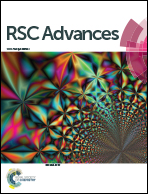A fluorescence-enhanced inorganic probe to detect the peptide and capsid protein of human papillomavirus in vitro†
Abstract
Cervical cancer is the second-largest killer of women worldwide. Development of biomarkers that can be used to efficiently screen cervical cancer would be extremely useful for clinical management. The presence of human papillomavirus (HPV) capsid proteins, L1 and L2, is extremely important clinically and warrants further examination of cervical cancer. The present study supplied an easy, cost-effective and efficient fluorescence-enhanced method to detect the cationic peptides of HPV capsid proteins by using an Eu-containing polyoxometalate. The binding-induced luminescence enhancement of EuW10 was further successfully used to detect HPV L1 pentamers expressed from Escherichia coli, which could be extended to detect other proteins involving a large amount of polybasic segments. The present study showed an excellent application of a type of inorganic material, polyoxometalate, to viral and biological science.


 Please wait while we load your content...
Please wait while we load your content...